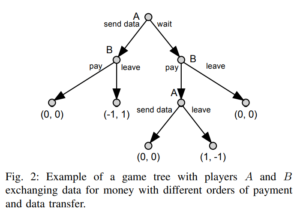We’ve all heard of the potential of blockchain technology – the defeater of banks, giving power back to the people, will revolutionize the world – but like all things, it has its setbacks. In this paper, researchers apply game theory with blockchain technology. More specifically, the fair exchange side of things. I decided to write about this because it was a pretty interesting paper to read. It contained concepts from this course, and CSCD71 (Blockchains and Decentralized Applications). As well, it was very cool to see a network science approach to blockchain.
Problem & Motivation
Typically, if you want to exchange goods over the internet you would rely on a third party to help mediate the exchange and prevent scams. This can be called a “three-party exchange”. Three-party exchanges require trust in the third party; trust that they have no conflict of interest and that they won’t take your goods and run). Third parties also charge a fee for their services. Blockchain and decentralized applications (dApps) try to solve this problem with their “two-party exchanges”. The dApp will act as a third party but is not considered a third party as the dApp will only act deterministically. It is good to note that a transaction (gas) fee is also involved with any transaction on the blockchain, but it is usually less than third-party services. Although, it can be just as high. It was noted that the gas fees got as high as USD 392.20 on the Ethereum chain.
The problem with this two-party exchange is that if one person initiates the exchange but the other person decides to quit halfway. The person initiating the exchange will be at a loss as they had to pay gas fees to start the exchange. This paper tries to address this and explores whether or not it is possible to make this two-party exchange a fair exchange. Fair exchange describes the challenge (or game) of two or more parties (or players) that want to exchange goods with absolute certainty that no player can gain an advantage over another. Ideally, we want something similar to the balanced equilibrium game discussed in class.
Game Theory
We just saw game theory charts in class, but in this case, it is easier to visualize player moves with a game tree. This is because only one player can initiate (send data) and it is the action of initiation that leads to loss.

Cost fairness has been defined by Lohr et al. and Buttyan and Hubaux introduced game theory as an approach to accessing different types of fairness. Researchers of this paper take it a step further by considering the value of items and transaction costs in the evaluation of fairness.
Conclusion
The paper concluded that two-party exchange protocols can exist that are fair for both parties. These protocols would also be able to cover additional financial aspects of the exchange, but transaction fees cannot be avoided. In terms of two-party exchanges on public blockchain-based protocols, it is impossible. But it is possible to mitigate risk on private blockchain-based protocols by banning those who leave halfway through the transaction.
That being said, this isn’t the end of blockchain technology. Sure, private blockchains may seem counterintuitive as blockchain is known to be decentralized. But at least this means we have options! We’re not stuck having to use banks or other third parties to exchange our stuff.
Feel free to read the paper linked at the end of this article for more details. https://arxiv.org/pdf/2203.05925.pdf
references
Lohr, M., Skiba, K., Konersmann, M., Jürjens, J., & Staab, S. (2022). Formalizing cost fairness for two-party exchange protocols using game theory and applications to blockchain.
2 replies on “Application of Game Theory on the Blockchain: Two-party Exchange Protocols”
I never knew there was this hidden layer about blockchains. The fact the person leaving a transaction has nothing to lose really gives no incentives to actually finish the transaction. The network validators could totally try to exploit this.
This seems very interesting, how basic understandings we take as granted such as when a transaction happens it must end can be exploited with different systems. I’m sure, or optimistic that there would be additional security to make the transactions more reliable. It also does seem like the similar problems merchants notably had before central banks popped up, so its actually really interesting and I am curious how this problem can be solved.